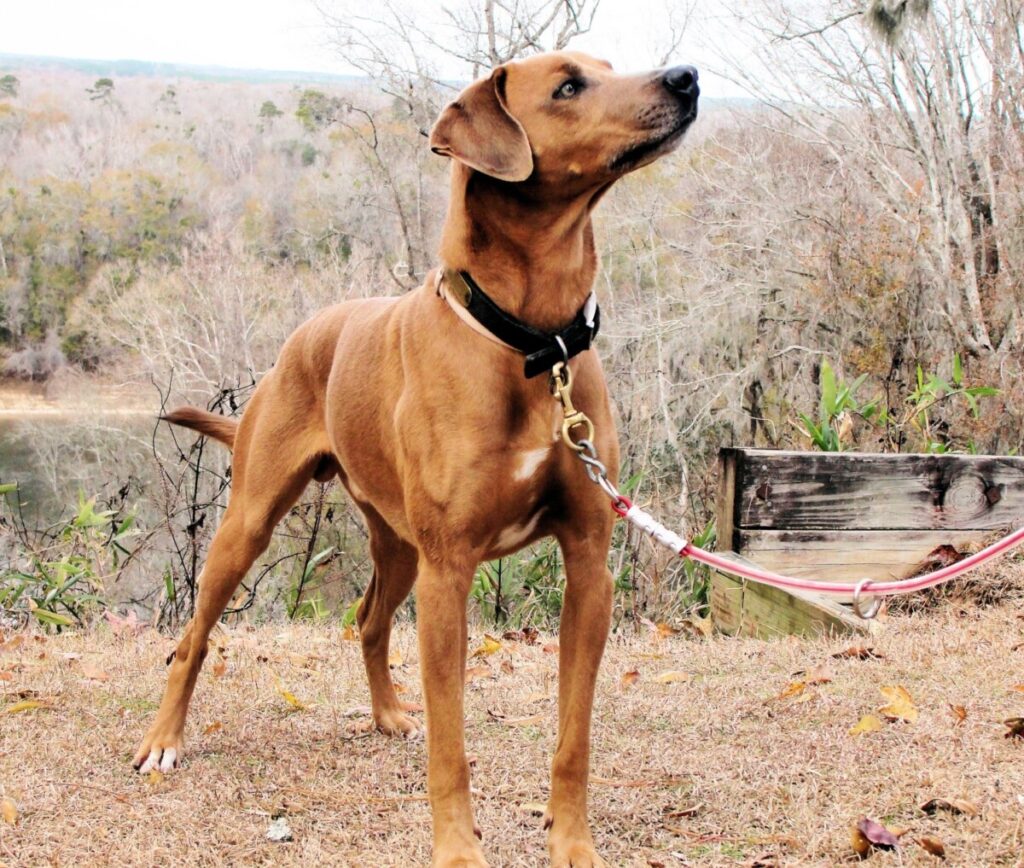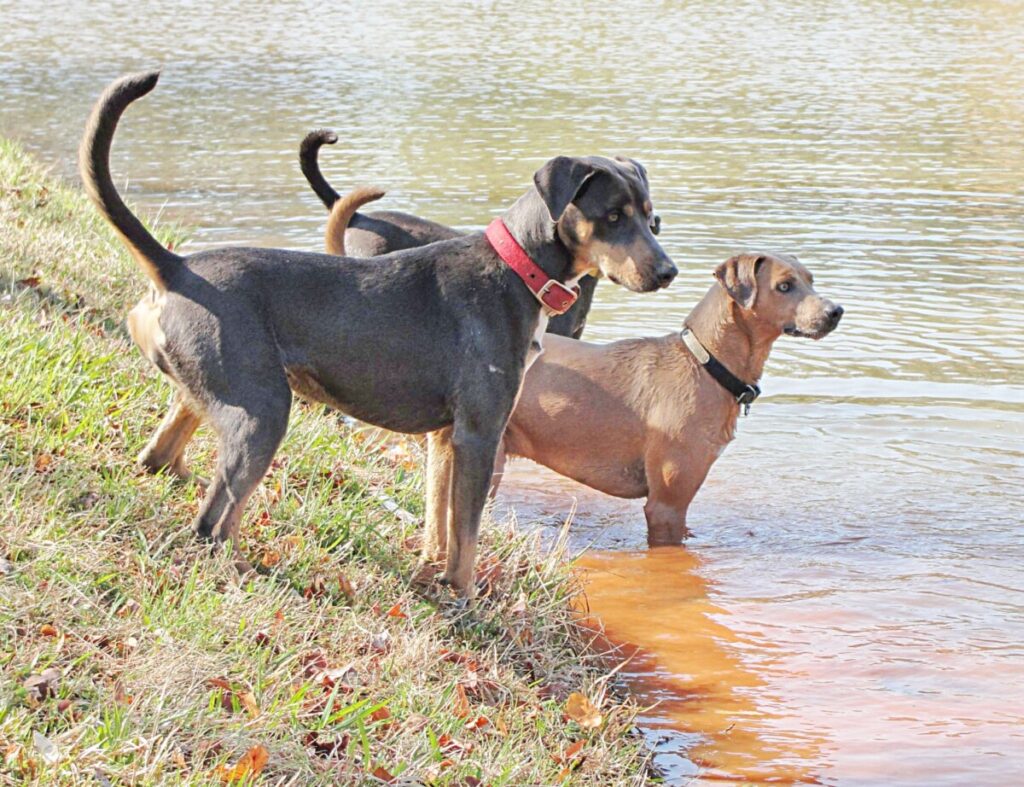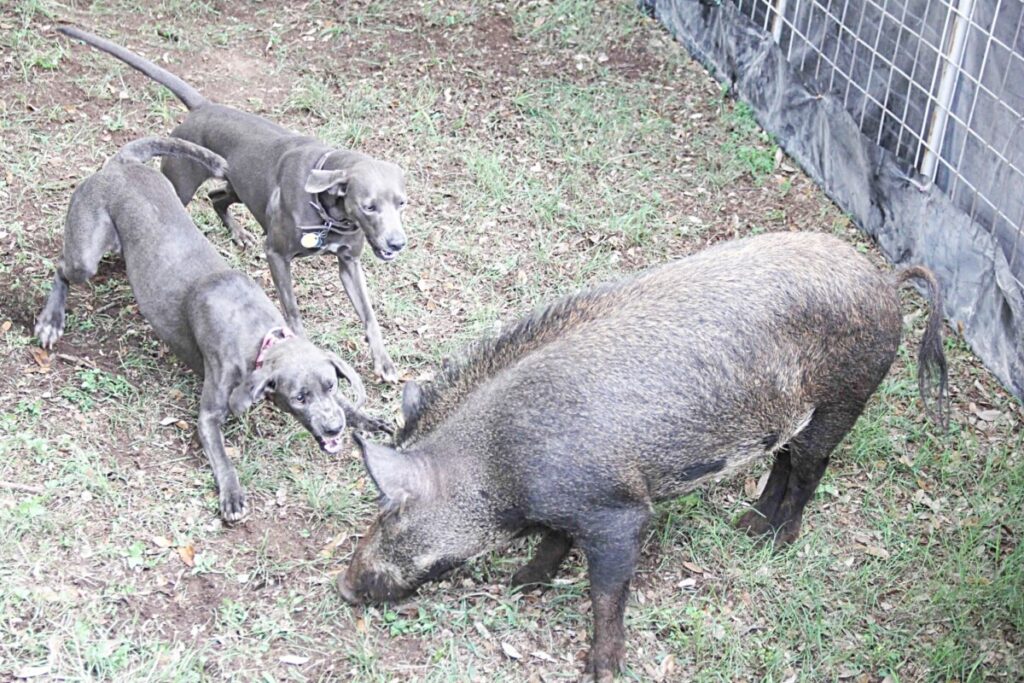GENERAL APPEARANCE
The Blue Lacy or Lacy, is a well-balanced dog of medium size and bone. Lacys are poised and alert; strong, muscular and active; intelligent in expression and symmetrical in outline. The Lacy mingles great looks with confidence and fine hunting talent. The Lacy’s conformation must be functional to endurance and speed in the field. Movement must be free and smooth and cannot inhibit work performance.
CHARACTER
Lacys are easy to handle, and can be spectacular working dogs. They are energetic and dedicated, capable of handling the meanest Longhorn cattle or the most jittery of hens. They are instinctively suited to the job. The Lacy is a working breed and does much better when given a job, which allows them to burn off excessive energy. It has been reported that they can replace a cowboy’s work by five times. This breed is also used for hog hunting, blood trailing, treeing, bird hunting, agility, and search and rescue. They are also suitable as watchdogs. Temperament is stable and outgoing, yet dignified. In Lacys, shyness is considered a major fault.
SIZE
Height at the withers is 18 to 23 inches for males and females. Females are ideally smaller than males. Weight is approximately 30 to 55 lbs. Disqualifications: Under 18 inches or over 23 inches at the withers.
COLOR
Genetic rarity accounts for slate blue coats and noses. All Lacy dogs have minimal to full white markings on their brisket and most of the time on their paws. The light gun-metal gray to almost black Lacys are classified as Blue. The red, yellow to cream colored Lacys are classified in color as Red * The tri-colored Lacys are blue with red points over their eyes, on the muzzle, under the tail and down the legs are categorized as Tri. Both the red and tri colored Lacy hold the name Blue Lacy due to the blue color gene they possess. Disqualifications: No white above the second joint of the legs, above the chin, on the head, or top and sides of the body.
COAT
They are smooth, tight, sleek and exceptionally clean in appearance, and not known to shed. Their coat is neither wooly, long, nor rough in appearance. The tail and hocks should be free of flagging or long hair. The coat is sleek, glossy and healthy in appearance. Dogs with alopecia will exhibit a dull, rough coat that is sparse and balding. The skin can be seen under the coat. In general, the tail, ears and across the spine is the most prominent areas for alopecia. A non-typical coat is a severe fault. Disqualifications: Overall long coat, with flagging on the tail and hocks. Dogs with Alopecia or Demodectic Mange.
HEAD
Lacys should have a head proportionate to their bodies. The top of the skull is flat to slightly rounded, but not domed. There is a moderate but defined stop. The flews should be tight and not droopy. The muzzle tapers to a rounded tip. The nose leather should be completely pigmented.
EYES – All Lacy eyes are a very bright and distinctive orange to yellow color, which adds a striking touch to their appearance. Brown eyes are faults. The eye set is slightly oblique, almond shaped, moderately sized, and expresses intelligence. It is neither prominent nor sunken, but well defined and perfectly positioned with dark pupils. A round eye is a fault.
EARS – The set is just off the skull at the side of the head, triangular and slightly rounded and 4 to 5 inches in length. Length is measured by bringing the tip of the ear across the eye to the muzzle bridge. Upon full attention, the ears bend slightly forward and lay to the side of the head. Pricked ears, long and/or leathery ears are severe faults.
TEETH – The teeth should meet in a scissors bite. There is a fault in a level bite. Disqualifications: Undershot and overshot bites exceeding 1/16 of an inch, and all wry bites for dogs born after January 1, 2012.
NECK AND BODY
The neck is medium length, firm, elegant and muscular, clean and arched at the crest; setting well into the shoulders. The body is firm and muscular. The top line appears level at a natural four-square stance. There is a penalty for roach backs or swaybacks. The chest is deep and comes to the elbow, with well sprung ribs, without being slab-sided or round. The loin is strong and broad when viewed from the top. The bottom line is carried well back with apparent tuck up. The croup moderately slopes towards the tail. The tail is straight and curls upward when the Lacy is on alert. A natural bobtail, crook tail or excessively curled tail is a fault.
GAIT
Smooth, free and easy; exhibiting agility of movement with a well-balanced, ground-covering stride. Fore and hind legs move straight and parallel with the center line of the body; as speed increases, the feet, both front and rear, converge toward the dog’s center line of gravity, while the top line remains firm and level.
FOREQUARTERS
Their shoulders are well laid back, measuring about three fingers apart at the tips of the withers and are very muscled. The legs are vertical when viewed from the front and profile. The elbows are close to the ribs and not loose. The legs are straight and powerful. Pasterns are straight and strong, but flexible. Feet are spoon shaped, compact with close knit and well arched toes. Pads are thick and resilient; the nails are strong. Dewclaws may be removed or left natural.
HINDQUARTERS
The thighs are strong and muscular. Angulation of both the stifle and hock joints should achieve the optimal balance of drive and traction. When viewed from the rear, the hocks are parallel to each other and low to the ground.
HEALTH
Lacys are generally very healthy dogs. Some are known to be 16 years old and still working. Developed for generations to meet ranchers and hunters’ requirements, they are sturdy enough to withstand tough terrain, difficult working conditions, and both hot and cold weather by Texan standards. However, skin problems and food allergies can occur. Color dilution alopecia is very rare, but occurs in Lacys. Note: Any diagnosed genetic disorder is a disqualifying fault, even after the LGDR Breeding Prospect Form has been submitted and is on file. Diagnosed genetic disorders must be reported to LGDR when discovered.






